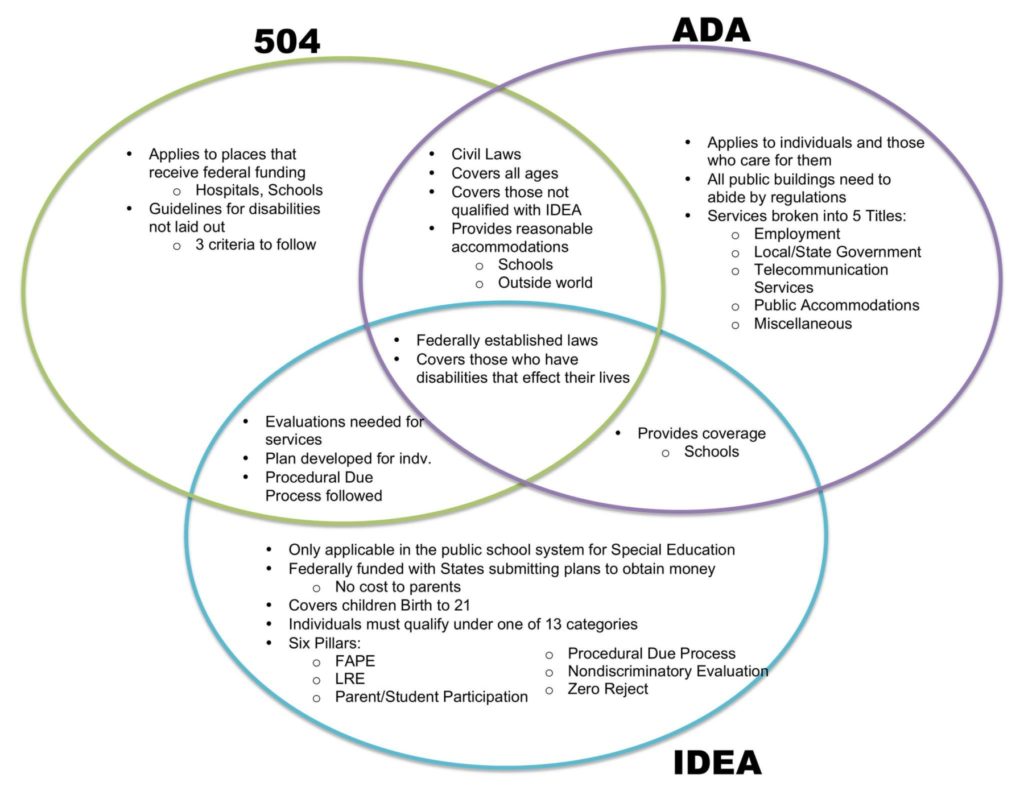As an educational advocate and a parent, it is crucial to understand the legal frameworks that support and protect children with disabilities. In the realm of education, three significant laws come into play – the Individuals with Disabilities Education Act (IDEA), the Americans with Disabilities Act (ADA), and Section 504 of the Rehabilitation Act. Each of these laws is interconnected yet distinct, providing various supports and safeguards for students with disabilities. In this article, we will explore the differences between these laws and how utilizing them effectively can ensure that all children with disabilities receive the academic and overall support they need to thrive.

The IDEA: Special Education Services in Focus
IDEA is a federal law that governs special education services for students with disabilities. Enacted in 1975, IDEA guarantees eligible children with disabilities the right to a free and appropriate public education (FAPE) in the least restrictive environment (LRE) possible. This means that schools are required to provide individualized education plans (IEPs) tailored to meet each student’s specific needs and enable them to access the curriculum alongside their peers.
IDEA covers children from birth to age 21 and emphasizes early intervention for infants and toddlers with disabilities. It ensures that students receive the necessary supports and accommodations, including specialized instruction, related services (such as speech therapy or occupational therapy), and assistive technology.
The ADA: Broader Protections Against Discrimination
The ADA was signed into law in 1990 and offers more comprehensive protections against discrimination based on disability. It applies to a broader scope, covering not only educational settings but also employment, transportation, public accommodations, and other areas of public life.
Under the ADA, individuals with disabilities are entitled to equal opportunities and access to facilities, services, and programs available to the general public. In an educational context, ADA prohibits discrimination against students with disabilities in public schools, colleges, and universities. This includes ensuring that school buildings are accessible and providing reasonable accommodations to enable students with disabilities to participate fully in all school activities.
Section 504 of the Rehabilitation Act: Ensuring Equal Access
Section 504 of the Rehabilitation Act is another vital piece of legislation that complements IDEA and ADA. Enacted in 1973, Section 504 prohibits discrimination against individuals with disabilities in any program or activity receiving federal funding. Unlike IDEA, which focuses specifically on education, Section 504 covers various settings, including public schools, universities, and private institutions that receive federal financial assistance.
Under Section 504, students with disabilities who may not meet the criteria for specialized services under IDEA can still receive accommodations and modifications to ensure equal access to education. These accommodations may include changes in classroom practices, testing, or the provision of auxiliary aids and services like sign language interpreters or note-taking assistance.
Utilizing the Laws Effectively
To ensure that children with disabilities receive the support they need to succeed academically and socially, it is essential to understand the unique strengths and limitations of each law. IDEA is specific to special education services and requires schools to IEPs to address the unique needs of each student. In contrast, ADA and Section 504 focus on broader anti-discrimination measures, extending their protection beyond the educational realm.
While IDEA ensures specialized educational services, ADA and Section 504 protect individuals with disabilities from discrimination in all aspects of public life. This means that children with disabilities can access not only quality education but also employment opportunities, transportation services, and public accommodations.
By collaborating with schools and advocating for the effective use of these laws, caregivers can help create an inclusive and supportive environment for their children with disabilities. Encouraging schools to implement reasonable accommodations, invest in accessible infrastructure, and provide sensitivity training to teachers and staff will foster a more inclusive learning environment.
Understanding the interplay between the Individuals with Disabilities Education Act (IDEA), the Americans with Disabilities Act (ADA), and Section 504 of the Rehabilitation Act is crucial for parents and educational advocates alike. While IDEA focuses on specialized education services, ADA and Section 504 provide broader protections against discrimination in various aspects of life.
By leveraging the strengths of these laws and advocating for their effective implementation, we can work together to ensure that all children with disabilities receive the support they need to succeed academically and as a whole. Building an inclusive and nurturing educational environment empowers children with disabilities to achieve their full potential and contribute meaningfully to society. Let us continue to champion their rights and ensure that no child is left behind.
